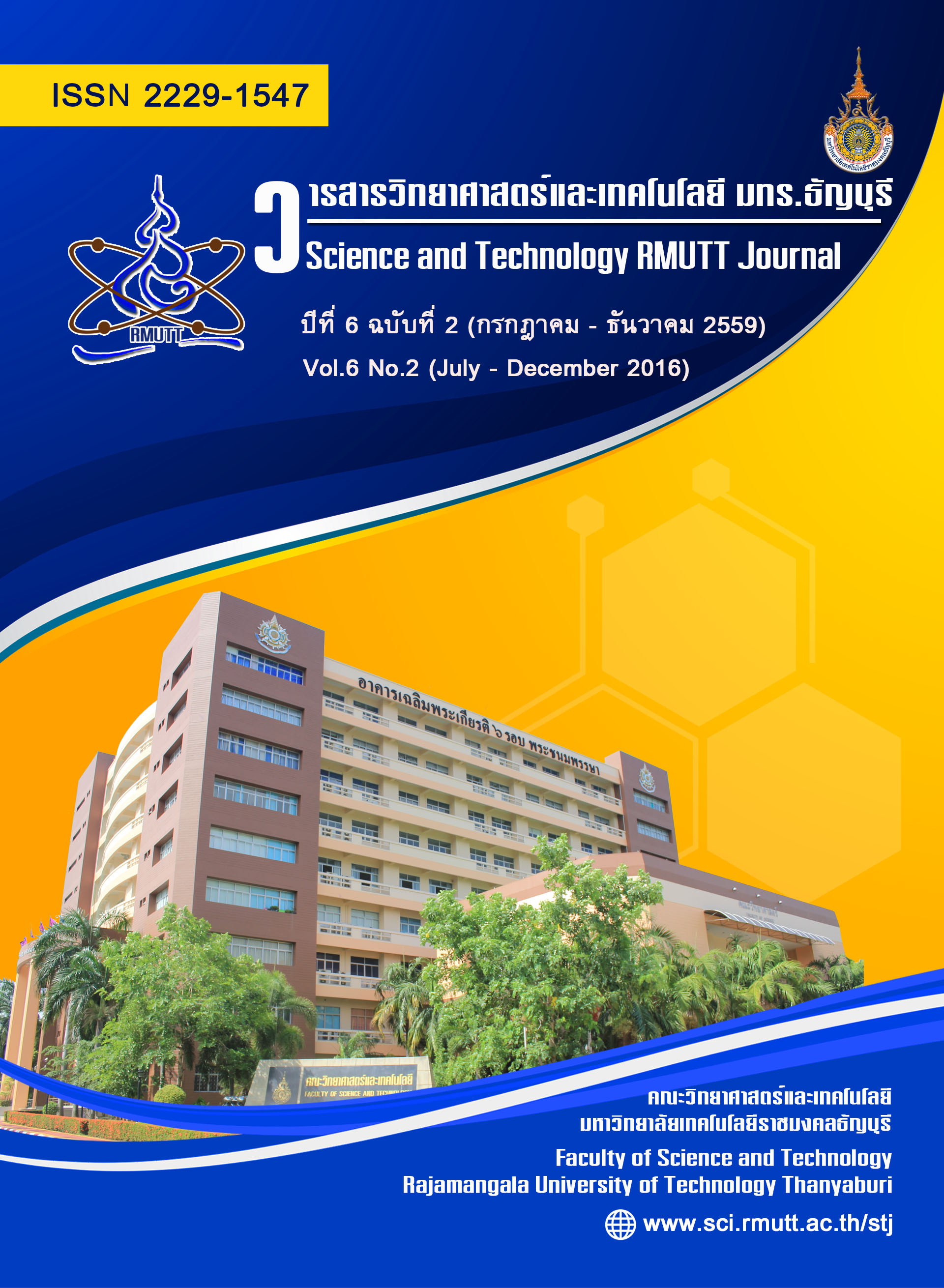Feasibility study of heavy metal removal from wastewater Using modified cassava leaves
Main Article Content
Abstract
The aim of this work is to study the feasibility of heavy metal removal (Cu, Cr, and Pb) from wastewater using modified cassava leaves. In this study, the modified cassava leaves adsorbent was treated with sulfuric acid. The optimum conditions for heavy metal removal from synthetic waste water were investigated. The parameters that effect on heavy metal removal from waste water consists of initial metal concentration, initial pH of waste water, weight of modified cassava leaves adsorbent and contact time were studies. The optimum condition for Cu removal consists of initial concentration 80 ppm, initial pH 5, weight of adsorbent 0.3 g, and contact time 1 h. The optimum condition for Cr removal was also study including initial concentration 80 ppm, initial pH 5, weight of adsorbent 0.2 g, and contact time 1 h. The optimum condition for Pb removal were initial concentration 150 ppm, initial pH 5, weight of adsorbent 0.3 g, and contact time 1 h. With optimum condition for metal removal using modified cassava adsorbent, the metal removal efficiency is 98, 97 and 95 percent for Cu Cr and Pb, respectively. The FT-IR spectra of the modified cassava leave was investigated to explore the position of functional groups available for the binding of metal onto adsorbent. SEMs of the adsorbents were determined to study the morphology of the studied adsorbents. The results show that the modified cassava leaves can be effectively used for the removal of heavy metal from waste water.
Article Details
References
T. A. Kurniawan, G. Y. S. Chan, W.-h. Lo, S. Babel, Comparisons of low-cost adsorbents for treating wastewaters laden with heavy metals. Science of The Total Environment 366 (2006):409-426.
A. Demirbas, Heavy metal adsorption onto agro-based waste materials: A review. Journal of Hazardous Materials 157 (2008): 220-229.
M. S. Masri, F. W. Reuter , M. Friedman, Binding of metal cations by natural substances. Journal of Applied Polymer Science 18 (1974): 675-681.
J. M. Randall, E. Hautala, G. McDonald, Binding of heavy metal ions by formaldehyde-polymerized peanut skins. Journal of Applied Polymer Science 22 (1978): 379-387.
A. M. Deshicar, S. S. Bokade, S. S. Dara, Modified hardwickia binata bark for adsorption of mercury (II) from water. Water Research 24 (1990): 1011-1016.
H. A. Hegazi, Removal of heavy metals from wastewater using agricultural and industrial wastes as adsorbents. HBRC Journal 9 (2013): 276-282.
S. Vafakhah, M. E. Bahrololoom, R. Bazarganlari, M. Saeedikhani, Removal of copper ions from electroplating effluent solutions with native corn cob and corn stalk and chemically modified corn stalk. Journal of Environmental Chemical Engineering. 2 (2014): 356-361.
M. S. Mansour, M. E. Ossman, H. A. Farag, Removal of Cd (II) ion from waste water by adsorption onto polyaniline coated on sawdust. Desalination. 272 (2011): 301-305.
S. Patel, Potential of fruit and vegetable wastes as novel biosorbents: summarizing the recent studies. Reviews in Environmental Science and Bio/Technology 11 (2012): 365-380.
T. Ogata and Y. Nakano, Mechanisms of gold recovery from aqueous solutions using a novel tannin gel adsorbent synthesized from natural condensed tannin. Water Research. 39 (2005): 4281-4286.
ธ. ภัทรกิตติ "การดูดซับโลหะหนักโดยใช้เปลือกถั่วเหลือง" ปริญญาตรี สาขาวิชาเคมี สถาบันเทคโนโลยีราชมงคล วิทยาเขตเทคนิคกรุงเทพ. 2545.
Q.-Q. Zhong, Q.-Y. Yue, Q. Li, B.-Y. Gao, X. Xu, Removal of Cu(II) and Cr(VI) from wastewater by an amphoteric sorbent based on cellulose-rich biomass. Carbohydrate Polymers 111 (2014): 788-796.
F. Gode and E. Pehlivan, Adsorption of Cr(III) ions by Turkish brown coals. Fuel Processing Technology. 86 (2005): 86, 875-884.
A. Gundogdu, D. Ozdes, C. Duran, V. N. Bulut, M. Soylak and H. B. Senturk, Biosorption of Pb(II) ions from aqueous solution by pine bark (Pinus brutia Ten.). Chemical Engineering Journal. 153 (2009):62-69.


